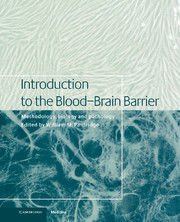Book contents
- Frontmatter
- Contents
- List of contributors
- 1 Blood–brain barrier methodology and biology
- Part I Methodology
- Part II Transport biology
- Part III General aspects of CNS transport
- 27 The blood-CSF barrier and the choroid plexus
- 28 Arachnoid membrane, subarachnoid CSF and pia–glia
- 29 Circumventricular organs of the brain
- 30 Transport in the developing brain
- Part IV Signal transduction/biochemical aspects
- Part V Pathophysiology in disease states
- Index
29 - Circumventricular organs of the brain
from Part III - General aspects of CNS transport
Published online by Cambridge University Press: 10 December 2009
- Frontmatter
- Contents
- List of contributors
- 1 Blood–brain barrier methodology and biology
- Part I Methodology
- Part II Transport biology
- Part III General aspects of CNS transport
- 27 The blood-CSF barrier and the choroid plexus
- 28 Arachnoid membrane, subarachnoid CSF and pia–glia
- 29 Circumventricular organs of the brain
- 30 Transport in the developing brain
- Part IV Signal transduction/biochemical aspects
- Part V Pathophysiology in disease states
- Index
Summary
Introduction
Seven small aggregates of tissue, that together account for less than 0.5% of the brain's volume (Gross and Weindl, 1987), have the vital role of transducing blood–borne, humoral signals into neural responses that maintain systemic homeostasis. Their location at the mid-sagittal surface of the cerebral ventricles suggests that the aggregates, designated as circumventricular organs (CVO), are in a position to participate in the exchange of substances between blood and the cerebrospinal fluid (CSF) (Fig. 29.1). They are able to receive solutes from blood and to release their secretory material into blood because they lie outside of the bloodbrain barrier. The morphological basis of the vessels’ permeability is like that for the capillaries of endocrine glands: a fenestrated endothelium, a constant feature of all but one CVO, the subcommissural organ. Accordingly, the structure, induction and physiology of fenestrated endothelium will be considered at length.
Fenestrated vessels
The endothelium of fenestrated vessels (FV) is passively permeable to hydrophilic solutes. FV are highly attentuated and perforated by clusters of holes or fenestrae, about 40-60 nm wide (Fig. 29.3), each spanned by a thin diaphragm, about 5 nm thick (Figs. 29.2 and 29.5).
- Type
- Chapter
- Information
- Introduction to the Blood-Brain BarrierMethodology, Biology and Pathology, pp. 270 - 276Publisher: Cambridge University PressPrint publication year: 1998
- 6
- Cited by



